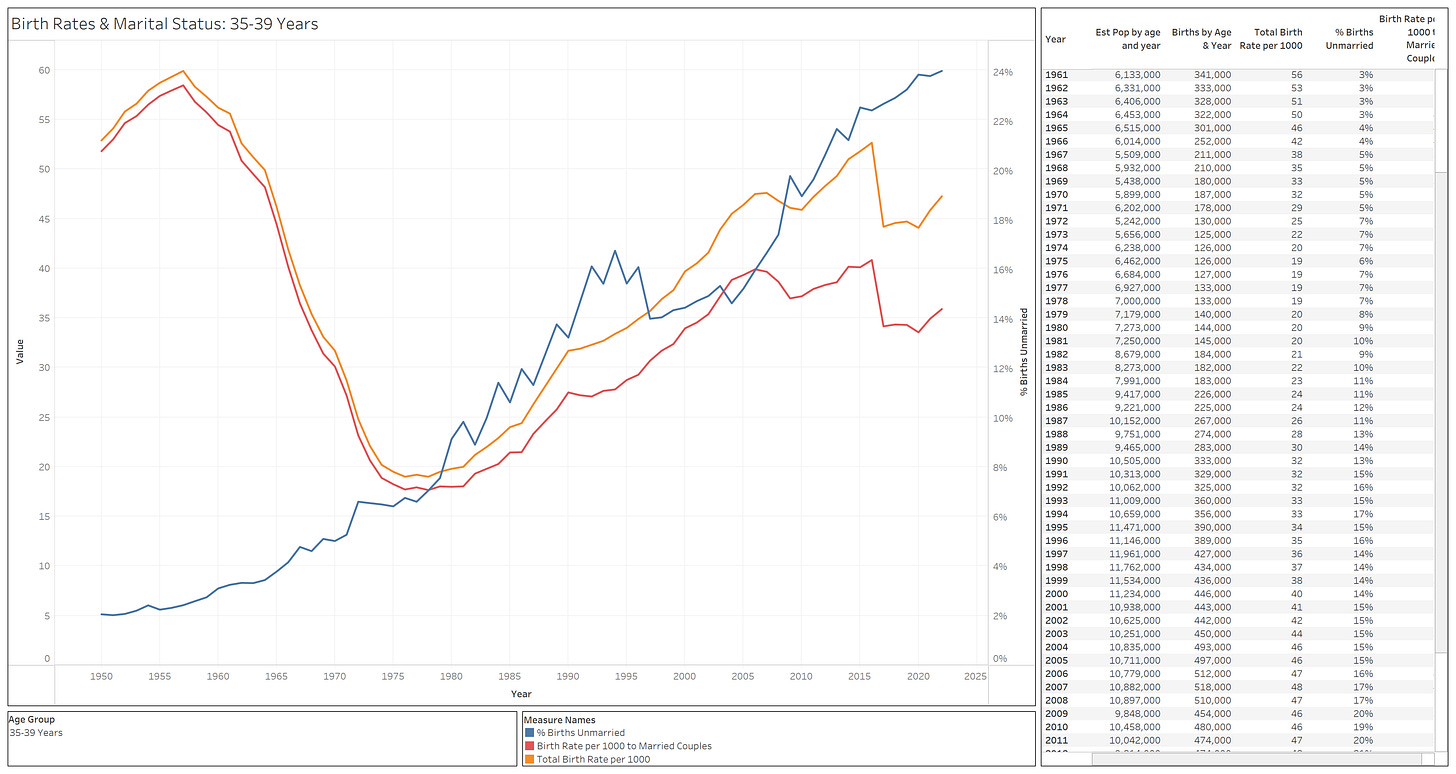Today’s Alex Berenson piece nudged me to write up some analysis I recently did on trends in births in the US. Alex correctly points out the demographic decline in most (all?) rich countries. My additional contribution is to add in information on the family structure of the births that are occurring. Namely, let’s look at two trends simultaneously:
The decrease in birth rate
The increase in fraction of births to unmarried couples
Why is it interesting to look at both? The research on improved life outcomes of children raised in homes with two parents vs. those who are not is vast and quite hard to counter. The point of this analysis is not to “judge” people who are having children outside of marriage, but if we are being honest, we will recognize the fact that, on the whole, human experience would tell is it is better to have a society with a large population people being raised in a home with married parents.
The following combines a couple different data sets produced by the CDC.
We start by looking at the birth rate per 1,000 women (orange line) vs. the % of births to unmarried couples (blue line) from 1950-2022:
As we can see, birth rate falls precipitously from ~1960 to the late ‘70’s, remains relatively flat until ~2010 and has declined quite a bit since then. The fraction of births to unmarried couples rises consistently until ~2010 and then seems to have remained stable. What we will see, in a moment, is that this last bit is a Simpson’s Paradox.
With the two pieces of data above, we can add a 3rd trend to the graph, which is the birth rate per 1,000 women to married couples (i.e. how many babies per 1,000 women in population are being born into a home of married parents):
The red line shows the birth rate to married couples. Now we can see that while the overall birth rate fell from 1950-2022 by ~54% (107.2 → 49.4), the birth rate to married couples fell by ~71% (103.12 →29.64).
By age group
Now we can break this down by age groups.
20-24
25-29
30-34
35-39
Summary
As you can see, the blue lines (% of births to unmarried couples) seemingly continues to steadily rise for every age group. The reason we saw a flat period since 2010 in the overall number is due to a Simpson’s Paradox. The fraction of babies born to older women was increasing during this time. Older women were more likely to be married, therefore the overall rate of children born to unmarried women stayed constant, even though it was increasing in each age group.
Births among women in their twenties have been steadily declining for decades. The decline in babies born to married women in the 20’s is even more stark. Women in their 30’s are having near the same number of babies as they were in the 1960’s, but not as high as the 1950’s. Although I can not be certain without having data source, I would suspect what we are seeing there, however, is a lot of women in their 30’s having their 1st or 2nd child vs. what might have been their 3rd or 4th a few generations ago.
Declining birth rates has been something that worries for a couple of decades now, but I only recently thought to combine this trend with the declining fraction of births that happen within marriage. We are really in uncharted territory here and it’s hard to see how we turn it around. A declining population, with a substantial (perhaps majority in near future) of people growing up in homes without married parents?











While I don't have the sources/links, there are some studies that confirm that religious couples (almost always married since that is part of a religious/faith understanding of God's intent for male-female relationships) have more children than non-religious couples. As we are becoming a more and more secular society (along with Western Europe, and really, much of the world), we are having less children per couple.
Two fairly intuitive reasons for this:
First, most world religions understand marriage as being "blessed" when it is fruitful and bears children;
Second, religious faith teaches selflessness, which is necessary to "happily" raise children. Secular people are more self-centered, and therefore less likely to make the sacrifices necessary to raise children - especially more than one or two.
It’s called socialism. Children don’t need parents and families when they belong to the state.